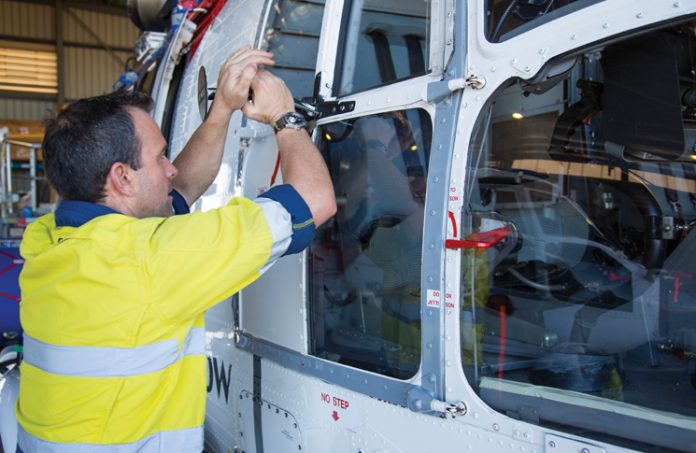Written by Ceri and Garth Bartlett, Bilyara Maintenance, Georges Hall, NSW
1 When changing a tyre on a light aircraft, it is normal practice to:
- align the tube stem opposite the red dot on the tyre
- align the red dot 45 degrees clockwise from the stem
- align the tube stem with the red dot on the tyre
- the relationship between the tube stem and the red dot is not significant
2 When a piston engine is running lean of peak:
- the engine will produce less power than when running rich of peak
- cylinder temperatures will be higher than when running rich of peak
- fuel consumption will be higher than when running rich of peak
- the engine may easily be damaged
3 In a simple piston-engine aircraft with an alternator and a 12 V battery, what should the charge voltage be closest to inflight, if the battery is fully charged?
- 12 V
- 14 V
- not above 13.1 V
- below 12 V
4 On most modern turbofan engines, when reverse is selected:
- only the core engine is reversed
- only the fan is reversed
- the core engine and the fan are reversed
- clam-shell doors open to redirect all thrust forward
5 The centre of gravity of a fixed-wing aircraft is always aft of the:
- fuel tank centre point
- second row of seats
- leading edge at the root of the wing
- engine
6 On climb in an aircraft with a normally aspirated engine, the mixture becomes:
- richer and the power increases
- richer and the power decreases
- leaner and the power increases
- leaner and the power decreases
7 A Dutch roll, which is a condition where the aircraft is unstable about the yaw axis, happens only:
- in high-speed aircraft
- in low-speed aircraft
- in aircraft with swept wings
- when flaps are extended
8 In a turbo-charged piston engine, ‘critical altitude’ is the altitude at which:
- throttle advancement does not result in an increase in manifold pressure
- throttle advancement increases the manifold pressure
- the engine runs rough due to the fuel control aneroid automatically leaning the mixture
- the engine runs rough due to a weak spark from the magnetos
9 When considering importing an aircraft from overseas, maintenance and repair data are accepted by CASA from:
- all ICAO countries
- USA and all European countries
- USA, Canada, South Africa, New Zealand and Britain
- USA, Canada, New Zealand, UK, France, Germany, Netherlands and EASA
10 Which of the following is not an effect of turbo-normalising a piston engine?
- Sea level power is achieved at cruise altitude
- A faster cruise speed is achieved
- Mixture can be leaner at cruise
- Power reduces during climb
11 Chines moulded perpendicular to a nose tyre are used to:
- deflect gravel from entering the engines
- deflect water from entering the engines
- aid keeping the nosewheel straight at high speed
- aid keeping the nosewheel straight during taxi
12 What is the main purpose of regular oil analyses in a piston-engine aircraft?
- to detect increasing trends of base metals being produced by the engine
- to identify broken internal components in the engine
- to identify when the engine needs overhaul
- to detect increasing trends of carbon in the oil
13 A helicopter lifts into the hover when the:
- rotor RPM reaches a certain speed
- pilot introduces the correct amount of anti-torque pedal
- engine governor allows take-off power to be reached
- pilot applies the collective control which increases the blade angle
14 In a light turboprop engine, the term ‘free turbine’ refers to when:
- the power section and the gas producer section are not connected mechanically.
- the propeller which is connected to the gas producer section, but not the power section.
- both power turbine and gas producer turbine which are connected to each other mechanically.
- the power section is started first and the resultant gases turn the gas producer turbine.
15 When the wheel hubs of large aircraft overheat, fusible plugs:
- melt and ensure pressure in the tyre remains constant
- melt and ensure the tyre does not deflate
- melt and release pressure in the tyre
- melt and prevent the brakes from overheating
Answers:
- (c)
- (a)
- (b)
- (b)
- (c)
- (b)
- (c)
- (a)
- (d)
- (d)
- (b)
- (a)
- (d)
- (a)
- (c)



I think the Quiz’s answer to Q4 should be (d). Am I right or wrong?
Please check the answer to Q 4 !! Errrmmmm, nope.
Ahhhhh, AIRFLOW reversal, not reverse the direction of rotation……. Hmmmm, thew word flow could help. :-)
I agree q4 b is correct, the Question is “modern” turbofan engines, all big rpt aircraft I have worked on, cf6, trent 700, rb211, cfm 56, p & w jt9,s, only fan air is re-directed foreward at 135 deg. Q 4 d is correct in relation to older engines where clamshell doors direct all thrust, turbine and fan air foreward like the older dc8,s and b737- 200.